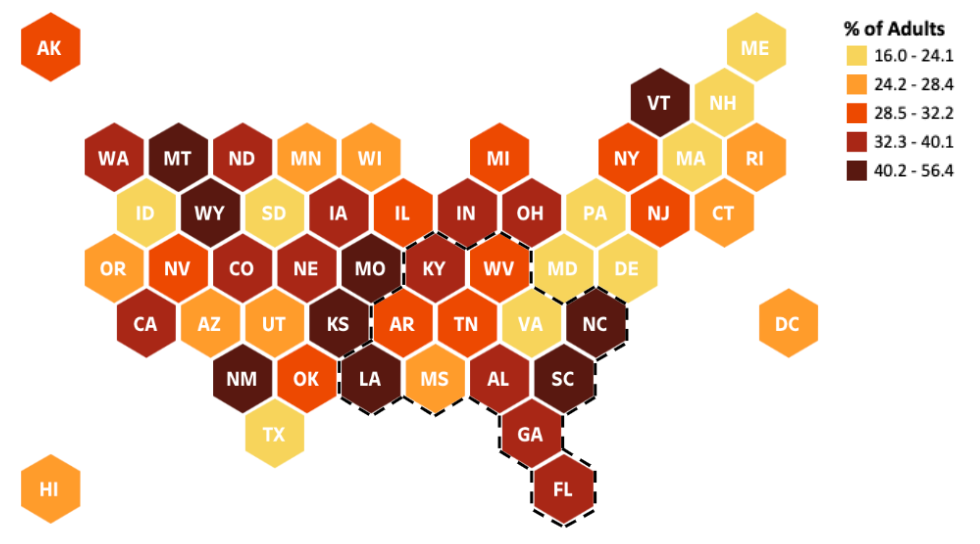Select a Data Category....
Explore Pandemic to Prosperity Data
Browse our data snapshots on topics like housing, jobs, health and more. View our full reports here.
Medical Debt, by race
During the pandemic, the Families First Coronavirus Response Act boosted enrollments in public health insurance plans such as Medicaid, which contributed to lowering the share of adults with medical debt from 24% in March 2019 to 17% in April 2021. When the health emergency officially ends, many people will lose their public health insurance.
Home Utilities Costs
Many Southerners with low incomes struggle to pay for home utilities. The Bipartisan Infrastructure Act greatly expands the Weatherization Assistance Program — allowing states and territories to access $3.1 billion in funding to install insulation, update heating and cooling systems, and upgrade appliances to reduce utility bills for households with low incomes.
Student Loan Debt
Before the pandemic hit, 1 in 5 families were saddled with student loan debt. The pause on student loan payments saved borrowers an average of $393 a month, an essential support as many struggled with unstable income over the course of the pandemic. Once student loan payments resume, it is estimated that roughly 18 million borrowers will lose $85.5 billion of their income annually.
Pediatricians
Pediatricians are an important source of behavioral and mental health care for children and recent polls reveal they are parents’ most trusted source of information on the Covid vaccine for children. The majority of rural counties in the U.S., however, have no pediatricians at all.
Pediatricians
Pediatricians are an important source of behavioral and mental health care for children and recent polls reveal they are parents’ most trusted source of information on the Covid vaccine for children.
Health Insurance Coverage
Without Medicaid expansion, hospitals don’t receive sufficient reimbursement for the care they provide to an increased number of uninsured patients and, as a result, oftentimes must close for financial reasons.
ACS response rates
As the nation’s largest household survey, with more than 2 million households responding per year, the ACS is the source of the most accurate, up-to-date, and detailed information about U.S. communities of any size.
Mental Health Providers
The majority of psychologists have seen their waiting lists grow since the pandemic hit. And many Americans are turning to crisis hotlines, which are also seeing ballooning demand.
2020 Census estimated-undercounts, by state
Undercounts (and overcounts) affect state and federal political representation and funding for necessities such as infrastructure, children’s programs, and health care.
Child Care Disruptions
Though child care disruptions have declined, families with children under 5 still face difficult child care decisions. Nearly 3 in 10 adults experienced a child care disruption at some point during the 4 weeks ending March 14, 2022.
2020 Census Net Coverage Error, by race / ethnicity
Census data has historically undercounted communities of color, with gaps widening this year for some groups. These undercounts reduce political representation and funding for affected communities nationwide.
Climate Disasters
Climate disasters have compounded the nation’s misery since the pandemic struck. 70% of Southerners live in a county that has had a disaster since March 2020 compared to 57% of non-Southerners.
Worker Retention
Since June 2021, more than 4 million employees have quit their jobs every month. The quits rate has been highest in leisure and hospitality (5.6% in February) and in retail (4.9% in February).
Job Growth
The Covid recession sparked the loss of almost 22 million jobs, which have been largely recouped only two years later. Among Southern states, 5 now have more jobs than they did in February 2020 before the pandemic hit.
Long Covid
Though the number of severe Covid cases has declined since Omicron peaked in early 2022, experts warn that “long Covid” may impact anywhere between 10% and 30% of Covid-19 patients, or 7.9 to 23.8 million Americans.
Drug overdose deaths
While the drug overdose crisis has grown over the last 20 years, fatal overdoses have skyrocketed over the course of the Covid-19 pandemic. Several Southern states are among those with the highest drug overdose death rates.
Excess deaths
For every 3 known Covid deaths, there has been 1 additional excess death. Early in the pandemic, health care providers noticed their usual patients, fearful of Covid, canceling care for cancer treatment, orthopedic issues, chronic disease, and other documented illnesses. New studies show additional previously hidden effects of the pandemic.
Well-being of LGBT population
In the South, LGBT adults were more likely than non-LGBT adults to have recently lost employment income and experienced food insecurity. In addition, nearly twice as many LGBT adults experienced anxiety compared to non-LGBT adults. Many Southern states have advanced anti-gay legislation in recent months and a recent survey found these efforts have negatively impacted the mental health of LGBTQ youth.
Symptoms of Anxiety or Depressive Disorder
When Covid struck, social isolation and uncertainty hit nearly every sector of society and economic woes deepened, particularly for low-wage workers. It is not surprising then that 32% of adults reported symptoms of anxiety or depressive disorder in March 2022, up from 11% in 2019.
Likelihood of eviction or foreclosure by state
Before Covid, 1 in 4 renters spent more than half their household income on housing. As recently as March 2022, 35% of Southerners (and 30% of non-Southerners) who are late on rent or mortgage payments were fearful of losing their homes.




















